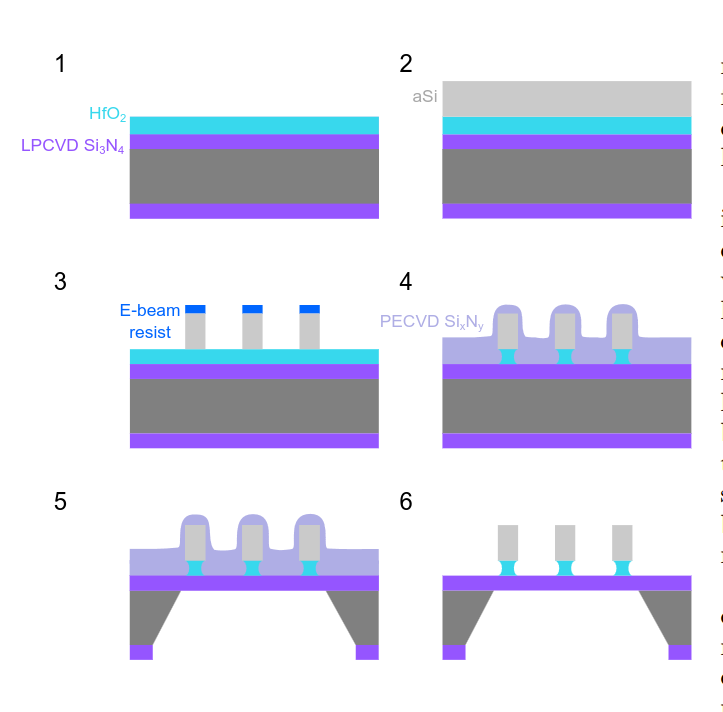Do I understand correctly- they successfully created a solid state oscillator at a scale where vacuum fluctuations become an important thermal factor, and overcame those factors to produce a (relatively short lived at thirty cycles) wave? What was the medium of the wave: air seems incorrect… light, I suppose?
What would one use such an oscillator for, or is this more a demonstration of what is now possible in optomechanics?
Kind of. I understand it a bit differently, but I might misunderstand some details. This is what I understand:
they successfully created a solid state oscillator
The resonator is a silicon nitride membrant with nanopillars grown on top to modulate its resonant properties. Here is an image from the supporting info showing how these are made, and the silicon nitride membrane that oscillates is the purple part:

where vacuum fluctuations become an important thermal factor, and overcame those factors to produce a (relatively short lived at thirty cycles) wave?
I think this is a mixture of two concepts that are mentioned, but the thermal influence and the vacuum fluctuations play different roles.
The noise comes from thermal fluctuations that are transmitted through phonons - no need to invoke vacuum fluctuations yet. At this large scale, the random phonons that naturally exist at room temperature will interact with the membrane as it oscillates, and so its motion over time is unpredicatable. Since the motion of the membrane is described in terms of its quantum-mechanical vibrations, the loss of this phase information means that the “quantum coherence” is decays very quickly due to noise. They have suppressed the noise by engineering the cavity in a way that specifically filters out the phonons that are most likely to interact with the membrane in a way that disturbs its oscillations.
The vacuum fluctuations were mentioned in the context of the fluctuations in laser intensity that are responsible for pushing the membrane such that it vibrates.
What was the medium of the wave: air seems incorrect… light, I suppose?
In the supporting info they mention that the device is in a vacuum chamber:
We also cannot exclude a small contribution to the observed dissipation due to collisions with the residual gas molecules in the vacuum chamber where the MIM cavity is located [19].
So it is not air. The membrane is the vibrating object. A laser provides the driving fields:
From the text:
In the textbook description of cavity optomechanics, the mechanical motion is driven by the vacuum fluctuations of the laser amplitude and transduced by the linear response of the cavity into phase fluctuations of the light field. The induced phase–amplitude correlation of the light field manifests as a noise reduction below the shot noise level (squeezing).
What would one use such an oscillator for, or is this more a demonstration of what is now possible in optomechanics?
In the introduction they specify a few examples. I quote from there:
Cavity optomechanics, in which the mechanical oscillator is dispersively coupled to an optical cavity, has enabled numerous advances, including ground state cooling, optomechanical squeezing of light and entanglement of separate mechanical oscillators. Yet, all these advances necessitate cryogenic cooling to reduce thermal fluctuations. Room-temperature operation is beneficial to the accessibility and widespread adoption of technology, as witnessed in other branches of physical science. Developing room-temperature quantum optomechanical systems would imply a drastic reduction in experimental complexity by removing the limitations imposed by cryocoolers such as poor thermalization, excess acoustic noise and limited optical access. Room-temperature operation could stimulate applications such as coupling to atomic systems, force microscopy and variational displacement measurements.
I don’t think I get all this nanoscale stuff.
I understand it a bit differently, but I might misunderstand some details.
I think that’s unlikely, but you’re very kind to phrase “no, dumbass” in that way.
I think that’s unlikely, but you’re very kind to phrase “no, dumbass” in that way.
Not at all!!! I like to make an effort to be helpful and learn myself in the process, but I also don’t understand all of the details and I don’t want to mislead others by saying something wrong with confidence 😄 I think that adding a disclaimer is a reasonable middle-ground. If an actual expert can chime in at some point it’s always appreciated - even if (or, especially if!) they call me out on how mistaken I am.
